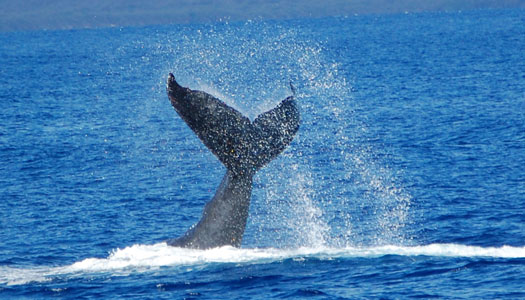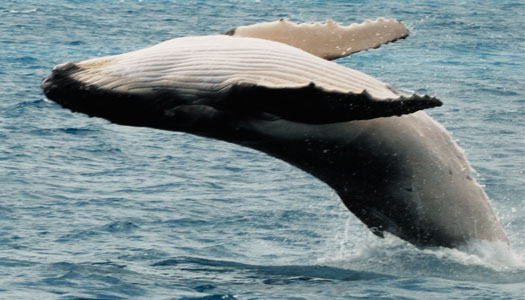Hawaii, especially Maui, is known for its winter humpback whale population. But it wasn’t always that way.
While more than 100,000 humpbacks lived in the oceans at the start of the 20th century, whalers hunted the animals until only about 1,000 remained in the North Pacific by the mid-1960s. In 1963, it became illegal to hunt humpbacks worldwide.
Since that time, humpback whale populations have increased to around 20,000 in the North Pacific—although the mammal is still on the endangered species list.
Whales can be seen in Hawaii beginning in November and are spotted more consistently in December.
“We’re dealing with wild animals in their natural habitat,” explains Merrill Kaufman, the education manager for the Pacific Whale Foundation. “It’s not like they’re on the clock. The season basically runs December through April.”
Humpbacks come to Hawaii to have babies. The warm, shallow waters are perfect for young whales to thrive. Plus, predators who may attack the calves—orcas and sharks—don’t live in great numbers in Hawaii.
“We like to say our whales are Hawaiian by birth,” Merrill says.
Cruise for Food
The Hawaiian Islands may be a great place to be born, but it’s not a good place to eat (as far as the whales are concerned).
Humpbacks don’t eat at all in the winter. Instead they rely on their blubber (the dense fat under the skin that keeps the whale warm and gives it energy). Humpbacks may build a blubber layer 8 inches thick before they leave their feeding grounds in Alaska and Russia. And that helps them survive until they migrate back to colder waters.
When the whales return to their feeding grounds, they’re hungry. A single humpback can eat up to 3,000 pounds of krill (like shrimp) and small fish a day.
Humpback whales rebuild their blubber in the summer before making the 3,500-mile trek back to Hawaii. The trip takes nearly five weeks, and the whales swim 24 hours a day.
“I still feel that sense of excitement and anticipation when the whales come back,” Merrill says. “And I feel a little bit of sadness when they leave. But you know how when someone goes away, you appreciate them more. It’s the same way for us.”
 |
We asked Merrill a bunch of other questions. Here are some of her answers:
Clubhouse: Whales are obviously very smart with their songs and migratory patterns. How do you measure whale intelligence?
Merrill: It’s really hard to do with an animal that’s not in captivity. What we know about dolphins comes from captive situations. But you can look at some anatomical things, such as surface area of brain tissue. Generally, when you look at intelligence, you look at available brain surface. So we know that cetaceans [whales and dolphins] are only behind primates [humans and apes] as far as having the highest surface-area ratio in their brain. After that you look at language, culture and how they live and adapt to the environment. All of these things give us a pretty good idea that marine mammals—whales, dolphins and porpoises—are intelligent.
How about the gymnastic ability of humpbacks?
They’re super acrobatic and known for a lot of aerial behaviors, breaching and peduncle rolls. That’s why people love to come watch humpbacks. Plus, those pectoral fins are there for a reason. No other great whale has anything like those. The angle of those peck fins results in an animal that’s 45 tons being able to turn on a dime. If you see them underwater, that’s very much evident. And the design [of their fins] has been emulated in lots of engineering—from aircraft wings to wind turbine props. They’re more of a teardrop shape.
Humpbacks do a lot of breaching. Do we know why?
There’s not a lot of research focused on the meaning of behavior. We know breaching happens in response to boat and aircraft activity. We know there’s visual ability for humpbacks to see in the air, and we often see a breach oriented toward something making a noise. So it’s reasonable to assume they breach in response to a sound to get a visual reference. It may be part of finding their way, according to geological features. It could also be a signal. A signal for what? I don’t know, but you’re going to hear that a long way away. We may see three to five pods on a boat and they all start breaching at nearly the same time. Coincidence? Maybe. But maybe not, it’s hard to say. Others say it’s a parasitic dislodging event. Most likely not here, because most of those have already fallen off by the time the whales get to Hawaii. For calves, it could be for muscle strengthening. That’s why a lot of animals “play.” It’s for training. They mimic behavior to strengthen their muscles.
Check out the March issue of Clubhouse for a cool whale poster!













